Generic structures
California is an imaginary country. I don’t mean that metaphorically (although the facility of the metaphor is obvious). “California” was the name of a utopian island in a 16th century romance; thus the actually existing state of California is doubly mimetic, a reference to what was avowedly fictional in the first place. Hence Dreaming California at the Berkeley Art Museum, which promises to “reveal the realities and the illusions of the California dream.” The ambiguity here is interesting and runs through the exhibition: a tension is set up between realities and illusions, but both alike are “revealed”; the curators avoid asserting that revealing reality thereby dispels illusions. The suggestion, amply illustrated by the photographs on display, is that the opposition between reality and illusion is not so simple.
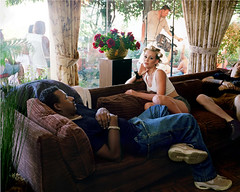 Larry Sultan’s series The Valley gives us a well-worn set-up for a confrontation between reality and illusion. With a series of photographs taken between takes on the sets of porn films, we might expect Sultan to expose a gap between the glamorous fantasy of pornography and the grim reality. But that is not what we get, the signifiers of “grim” are not represented here. The films Sultan documents were shot in rented suburban houses, and what we see is the minor oppulence, the banal glamor of these mass-produced detatched mini-mansions. The true subject of The Valley becomes clear in the conjunction created by this exhibition with pictures from another series, Pictures From Home. Here, we have pictures of the same suburban housing, likewise from the San Fernando valley. But this San Fernando house is the home of Sultan’s parents. Sultan says of the two series:
Larry Sultan’s series The Valley gives us a well-worn set-up for a confrontation between reality and illusion. With a series of photographs taken between takes on the sets of porn films, we might expect Sultan to expose a gap between the glamorous fantasy of pornography and the grim reality. But that is not what we get, the signifiers of “grim” are not represented here. The films Sultan documents were shot in rented suburban houses, and what we see is the minor oppulence, the banal glamor of these mass-produced detatched mini-mansions. The true subject of The Valley becomes clear in the conjunction created by this exhibition with pictures from another series, Pictures From Home. Here, we have pictures of the same suburban housing, likewise from the San Fernando valley. But this San Fernando house is the home of Sultan’s parents. Sultan says of the two series:
I find a lot of depictions of suburban life to be quite shallow. Either they’re hypercritical, like new topographics where tract homes are seen as generic structures for generic lives, or they’re the kind of one-dimensional dramas or sitcoms that are prevalent in popular culture. Neither of these depictions get to the complex desires or longings underlying this great American dream of suburban home ownership. To me, the suburban home is a kind of projection screen for fantasies, it’s rich for storytelling.
The subject is not the fantasy of pornography, but the fantasy of suburbia. So the Larry Sultan photos hanging by the door of the gallery are a perfect introduction to the Bill Owens series, Suburbia, that makes up the second major portion of the exhibition. Owens’s great virtue here is to be able to imagine a response to kitsch other than the faux-incredulity of hipster irony. Surely no-one is really surprised at this point to be confronted with evidence that the tastes of the ’70s were wildly different from our own, making the “OMG” response to kitsch an unilluminating instance of bad faith. Owens does something more interesting, considering how what we might call kitsch actually functions physiologically and affectively. So we see the glistening red wetness of a formica toilet-seat, or a picture strewn with the naked bodies of CPR dolls. The allure of the artificial.
Or, we might say, the libidinal charge of the suburbs. What’s interesting about Owens’s collection of pictures is how it re-imagines the lack of natural, organic, community in the suburbs as a kind of blankness or possibility, and thus as a particuarly American kind of utopia. Anyone who has taken an undergraduate course on Thomas More probably had it impressed on them that “utopia” is a pun in greek, from eu-topia (good place) and ou-topia (no place). Owens inverts the sense that is usually given to this double meaning: here it is precisely the blankness of the non-place that makes it possible to imagine it as a good place. Sultan’s comment about “generic structures for generic people” should thus be re-read with “generic” in Badiou’s sense, as that which is outside the law of a given situation. The title of Owens’s picture of a group of ageing swingers points precisely to this: “We don’t have to conform.” The evacuation of anything natural or given allows for a “lawlessness” of an entirely unheroic sort, which remains utopian for all that. Inauthenticity, the lack of an identity, is also the absolute freedom which is the fantasy of the suburbs.
The complex relationships between fantasy and identity link Sultan’s and Owens’s work to the definitely non-suburban pictures of Ruth Marion Baruch, which made up the third portion of the exhibition. The two sets of photos juxtaposed here again suggest a simple reading. Comparing the department store scenes of Illusion For Sale, San Francisco with the hippie pictures of Haight Ashbury, the exhibition notes point out, shows that “the search for identity was no longer a retail experience.” Is that to contrast the two, presumably to the benefit of Haight Ashbury authenticity? Or to cynically unite them, suggesting that the hippie experience was no more than another sort of “retail experience”? Again, the photographs themselves make it hard to sustain any of these binaries. Tucked away in the Haight Ashbury pictures is a shot of a cardboard sign stuck in a window somewhere, with the legend:
If I could believe wearing beads made men hippies, I could believe removing them would make men free.
This, I think, gets to the heart of Baruch’s pictures, which neither praise nor condemn the “search for identity,” but instead begin to undo identity. Their theme is that recognizing identity as a social construct is double-edged; while it might allow us to understand identities as non-normative, it also suggests that we can never cease to produce identities through our practice. Identity is not a matter of simple choice, neither wearing beads nor taking them off. Baruch’s pictures illustrate this in a variety of ways, through the moments they capture (exceptional? typical? we can’t tell), and through the way they are framed, cramming in or excluding details, demonstrating that identity is always in part imposed. “Young blond thoroughbred” focuses on a tall, beautiful young woman; we only glimpse blurred, reaching from out of frame, the the stocky arm of the shopgirl allowing the “thoroughbred” to inhabit that identity at all. In “Woman in a black dress which is too tight,” Baruch crops the picture so tightly the constraint of the dress becomes an ontological constraint, removing anything other than this woman, her body formed by the too-tight dress.
The conjunction of Illusion for Sale and Haight Ashbury is compressed into one picture, “Filipino girl with long hair holding up bridal gown.” The picture is divided sharply down the middle. On the left, we have the girl of the title, gazing with a clear pleasure that suggests plenitude, into the right half of the frame. In that half of the picture we see, reflected like some kind of mirror which is more truthful than a mere empirical mirror, the empty wedding dress which is the object of her gaze. Again we see the pure emptiness of fantasy, but this image completes what is latent in the rest of the exhibition: the centrality of the fantasy to any subjectivity. The fantasy is not to be accepted or rejected, to be appraised as either true or false; it is an empty space to be stepped into. It is what you make of it, or what it makes of you.
Do not give up on your desire.
One comment
Leave a comment
Sorry, the comment form is closed at this time.
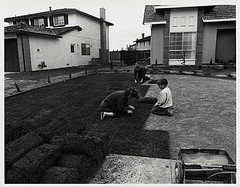
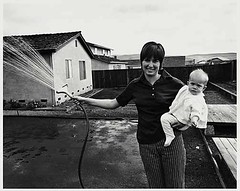
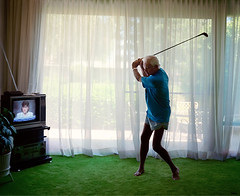
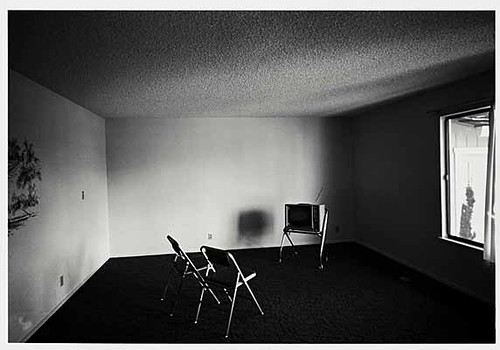
Thanks for a lovely, thoughtful post, written with a deft and nuanced touch.
Comment by itinerarium @ 2/18/2006 7:29 am